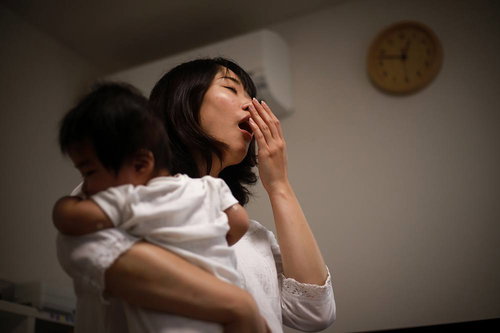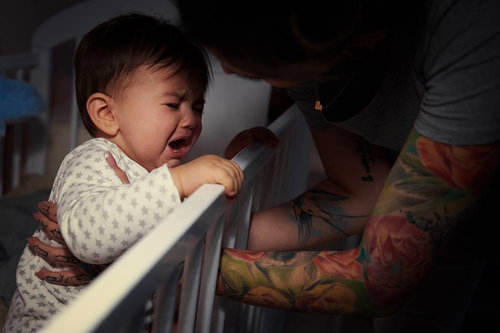Are you having a hard time getting your baby to sleep without having to be rocked or nursed? If your baby is getting big enough, it may be time to start sleep training your little one. Not familiar with this? Let’s find out how to sleep train your baby!
Table of Contents
What is sleep training for babies?
Is sleep training safe?
What are the benefits of sleep training?
What are the different sleep training methods?
What are other tips and tricks to help baby sleep?
Skip ahead to any section you find the most interesting!
Every Mama is familiar with this scene: nursing your child to sleep with the hope that you could make a quick escape at night but always ending up unable to do so. Why? Because your baby refuses to sleep without you by your side or is easily woken up when they don’t feel you beside them.
While it’s heartwarming to have that close bond with your little one, it can be incredibly difficult for parents and babies. The constant disruption in sleep can lead to stressful days and poor learning in babies. On the other hand, parents also tend to struggle with stress and anxiety because they cannot do anything else apart from snuggling or nursing their babies.
That’s why for some Mamas and Papas, sleep training is a skill that they strive to unlock for themselves. Not only will it teach babies independence, but it also gives parents some time for themselves.
What Is Sleep Training For Babies?
Sleep training is the process of helping babies learn to sleep on their own without assistance throughout the night. In addition, sleep training also teaches babies how to go back to sleep on their own after waking up at night.
According to paediatrician Noah Schwartz, MD, sleep training is simply “getting your baby to realize that they can put themselves to sleep or self soothe.” He furthers that “it’s a development skill they will need to learn.”
So, when is the ideal time to start sleep training? Contrary to popular belief, you don’t need to wait until your baby has weaned off the boob or the bottle to sleep train. In fact, Dr Schwartz recommends sleep training to begin at about four months old.
Is Sleep Training Safe?
In the west, sleep training is widespread. However, in most Asian countries, sleep training is not as heavily practised because of some cultural differences. For instance, most Asian families still practice sharing a bed with a baby or co-sleeping. Moreover, some conservative families also aren’t too open about the idea of leaving a baby to sleep by themselves.
But rest assured, Mama, that sleep training is safe as long as safe sleep practices are followed. In fact, there have been multiple studies that reveal sleep training to be safe and effective. One study, in particular, discovered that kids who were sleep trained when they were infants slept better by 2 years old.
Benefits of Sleep Training Your Baby
Sleep training your baby won’t make parenting a walk in the park, but it will surely help lighten the “load” a bit. With a sleep-trained baby, Mamas can catch up on their much-needed sleep, spend some quality time with Papas, or tidy up the house a bit.
If you think that sleep training is only for Mamas’ benefit, you’re wrong. With proper sleep training, babies can sleep by themselves without depending on your or your boob. This teaches them self-soothing, which is essential for infants, and as highlighted by many paediatricians.
In an article written by Sujay Kansagra, MD of the Pediatric Neurology Sleep Medicine Program at Duke University, he highlighted that some studies showed “improvement in security between parent and child following sleep training.” In addition, there is also improvement in the sleep quality for children, which in turn, is beneficial for babies’ physical and brain development.
Convinced that sleep training is the right choice for your family? Then, keep reading for several sleep training methods recommended by experts.
The Different Sleep Training Methods
Sleep training won’t be easy. But thankfully, there are several sleep training methods that you can try with your little one. Here, we’ll focus on the four most popular sleep training strategies.
1. The No Tears Method
This method, also known as No-Cry Method, is all about picking up your baby whenever they cry, soothing them, and helping them go back to sleep.
Tip: Have a fixed schedule for naptimes and bedtime to establish a routine for your baby.
2. The Cry It Out Method
In contrast to the No Tears Method, where soothing is still part of the sleep training process, this method is grounded on the belief that babies will eventually stop crying. Before implementing this method, your baby must be full, and your baby’s diaper must be clean.
This method is a bit more difficult for Mamas because you have to put down your baby while still awake and allow your baby to sleep on its own. You also have to let your baby cry it out. Mamas need to steel themselves and refuse to give in to their babies’ cries for this sleep training method to succeed.
Tip: Try to put down your baby before he/she becomes overtired. An overtired baby if more difficult to put to sleep.
3. The Ferber Method
A middle ground between the No Tears and Cry It Out methods, the Ferber Method is all about allowing your baby to cry for a certain amount of time before you go in and examine your baby.
Eventually, lengthen the time between your checks. For example, you can let your baby cry for 5 minutes before checking on them during your first try. Then, on your next attempt, allow your baby to cry for 10 minutes.
Tip: With this method, don’t pick your baby up but instead just verbally soothe or pat them.
4. The Fading Method
Perceived as the middle ground between the Cry It Out and No Tears Methods, the Fading Method is all about slowly easing out of your baby’s regular sleeping strategy. For example, if your baby is used to being rocked to sleep, do it less until your baby can fall asleep without being rocked any more.
Tip: The fading method is ideal for babies between 4 and 6 months.
Tips & Tricks To Help Your Sleep Training
Besides these tried-and-tested sleep training methods, establishing a bedtime routine is perhaps one of the most essential secrets to sleep training success. In a nutshell, a good bedtime routine for a baby would include:
- A set bedtime
- An atmosphere conducive to sleeping (lights off, relaxing music on)
- A calming bath before bedtime
With a calming bath often the first thing you need to do to prepare for bedtime, it would be more beneficial to use products that promote sleep. Bath soaps that contain lavender, for instance, are great options. That’s because lavender is clinically proven to help calm down babies and enhance their sleep, after all.
Also read: The Best Tips To Help Baby Sleep
The Takeaway on How To Sleep Train Your Baby
Sleep training is beneficial for any family, but if you’re planning on embarking on this journey, you have to remember that consistency is essential. If you fail, try not to stress too much about it and try again tomorrow. Strive for progress, not perfection, Mamas!
With all the information we shared, we hope you feel more confident on how to sleep train your baby. Good luck, Mama!
Did you find our article about how to sleep train your baby helpful? Then, click the share button and help another Mama out!
Mama's Choice Team
A team of passionate writers, young mamas, and creative superheroes who help mamas face motherhood one educational article at a time!








